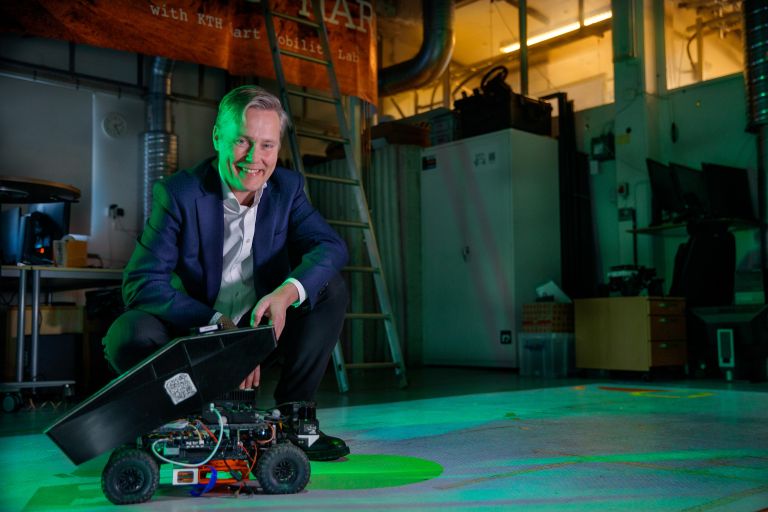
Karl Henrik Johansson
Professor of Network Control
Wallenberg Scholar
Institution:
KTH Royal Institute of Technology
Research field:
Control of dynamic networks


Wallenberg Scholar
Institution:
KTH Royal Institute of Technology
Research field:
Control of dynamic networks
A decade ago many people believed that self-driving cars would come to dominate our streets, but it hasn't happened yet – why?
“Today, we can automate text, images and videos – we’ve seen fantastic advances in recent years. But transport is a physical system that is much more complex. Safety must be guaranteed, despite unknown environments, unexpected situations and infinite number of potential events that can happen,” says Johansson.
Although much can be learned from the success of the latest generative AI models, a different kind of physical AI is needed, where problems like how best to collect and process real-time data to teach traffic systems to improve and adapt to users need to be considered. Instead of AI, Johansson calls it IA: Intelligent Automation.
“It’s about how we can use algorithms, sensors and data to create systems that are more intelligent, safer and resilient than current systems. And on a different scale – not just controlling a single machine or robot but automating critical systems in safe infrastructures.”
KTH Integrated Transport Research Lab (ITRL) is the heart of experimental research. Experiments take place in two cavernous halls, and involve everything from drones to self-driving cars. 3D printers are lined up along one wall, and there is an advanced vehicle simulator in an adjacent room. Johansson settles behind the wheel to demonstrate the system.
Researchers in the lab plan and coordinate trials ranging from remote-controlled vehicles on a test track at Arlanda Airport to trucks in Arvidsjaur equipped with sensors whose data train machine learning models to automatically adapt to winter conditions.
“It’s important that data come from real-world trials in real environments. So we are also working closely with industrial companies like Ericsson and Scania. We need to understand the daily challenges they face and ensure our results are applied in services and products.”
One focal area for Johansson over the next few years is models for automating traffic flow on highways. Connected cars and mobile phones will provide data for better traffic management. Small adjustments – like automatically reducing speed from 90 to 88 kilometers per hour – can greatly improve traffic flow.
The question is how we can use intelligent automation to reduce emissions – not only from the transport sector but also from industrial process and buildings. We’re researching how to learn physical AI models to manage large-scale systems of this kind.
“Passengers will hardly notice the difference, but it has a big impact on traffic flow. We’re building models and algorithms that can manage these systems on a large scale.”
The first step is a traffic environment that combines self-driving cars with human drivers. This situation, called mixed autonomy, requires knowledge of how people act in various situations. The models learn to cope with our choices by studying how drivers behave, for instance when they overtake or change lane.
“It’s incredibly exciting. We’re studying driver behaviors and the system’s reactions. How does a risk-prone driver affect the system? We use theories from psychology and behavioral economics to understand how people make decisions when they are unsure what to do.”
The long-term goal is to train models that can make decisions even when something unexpected happens – and teach them to take account their surroundings. A self-driving bus approaches a parked truck. The bus plans to overtake but notices a pedestrian crossing ahead of the vehicle.
“In that situation, there’s reason to assume a pedestrian might suddenly appear. Perhaps there’s also a day-care center by the roadside. Drivers are incredibly skilled at adapting to these environments thanks to our ability to generalize. Getting a system to do the same is a major challenge.”
One way to meet that challenge is to create systems in which vehicles share information with each other. If one car detects something, others can benefit from it immediately. Each sensor becomes part of a network in which everyone contributes to decisions – in real time.
“We’re not trying to model humans. But we are trying to model how humans interact in a system with vehicles and machines that are fully or partially automated. That’s the key to creating future systems that are safe, understandable and sustainable,” says Johansson.
The benefits of intelligent automation are not just fewer traffic jams on the highway. More efficient management can reduce carbon dioxide emissions from the transport sector. There’s also great potential for improvements in industry and other sectors. But technology alone is not enough; research must be conducted in collaboration and from a societal perspective.
Johansson heads the Digital Futures research center, founded by KTH Royal Institute of Technology, Stockholm University and RISE. More than two hundred research teams are collaborating with industry and public sector to contribute to the digital transformation of society.
“When researchers, companies and the public sector work together, we can create an ecosystem involving start-ups and the next generation talent in which scientific research results are put to use much more quickly,” says Johansson.
“Sweden has a great advantage with our traditions of collaboration across disciplines and societal areas. With AI and digitalization, we want to take this to another level.”
Text Magnus Trogen Pahlén
Translation Maxwell Arding
Photo Magnus Bergström